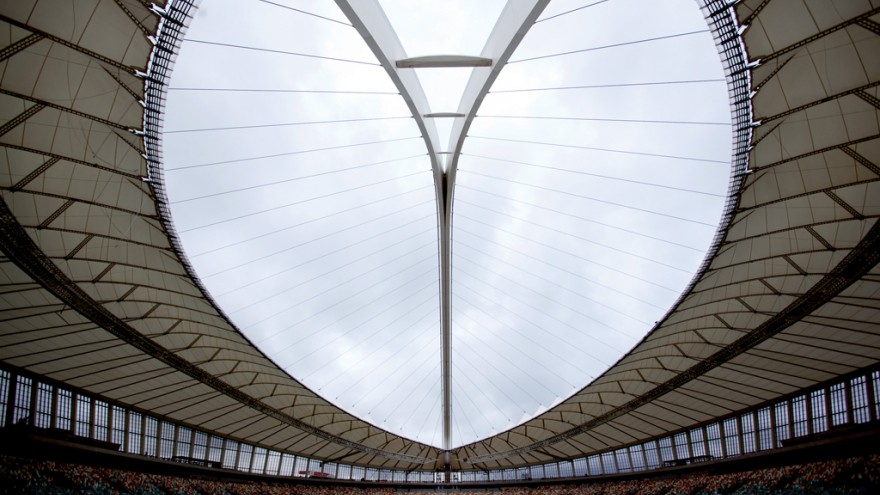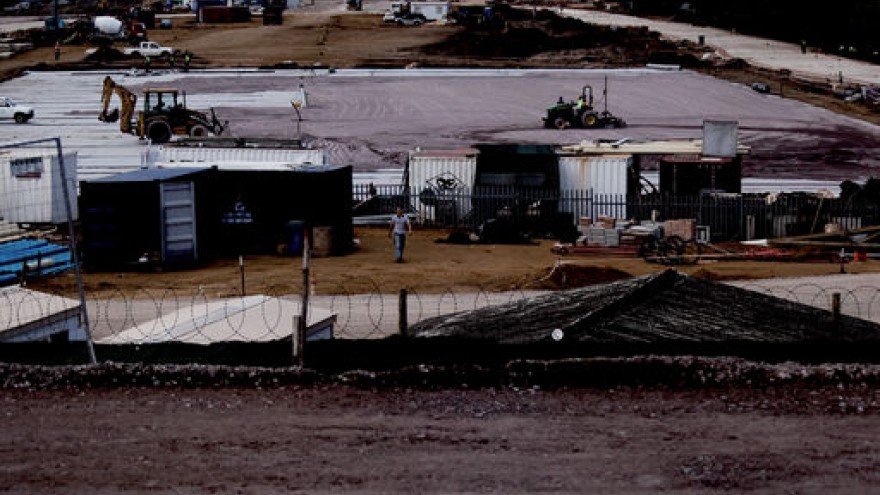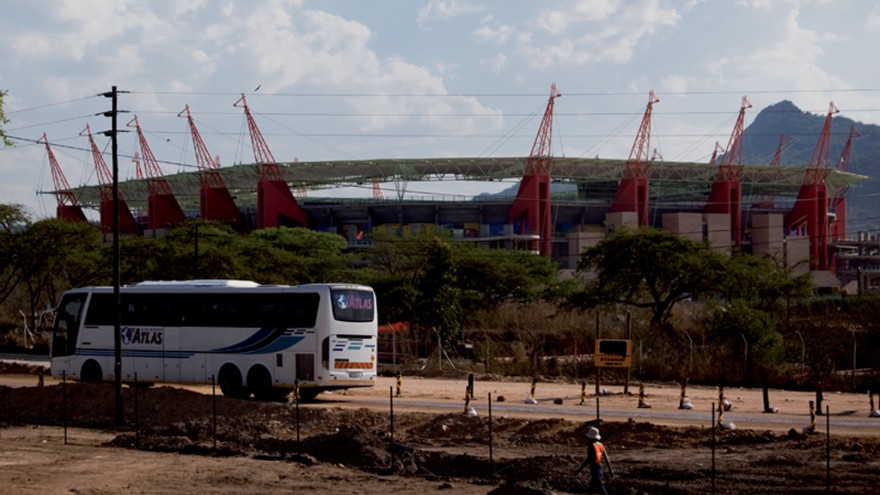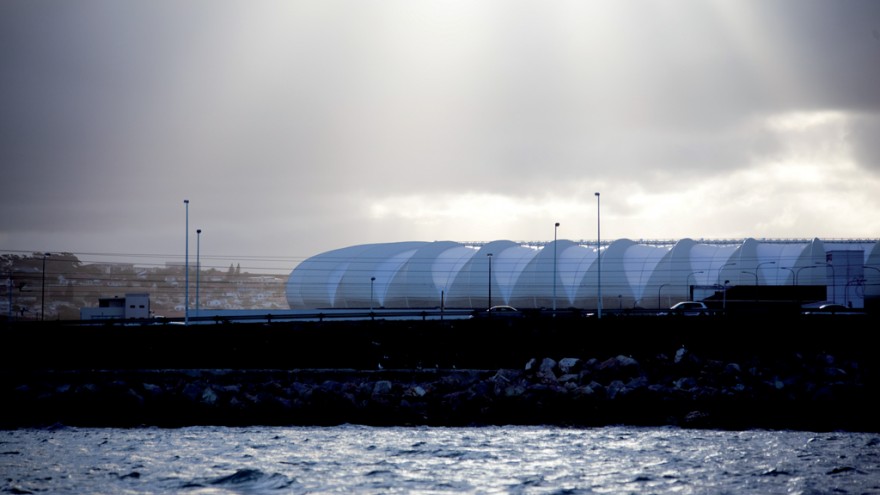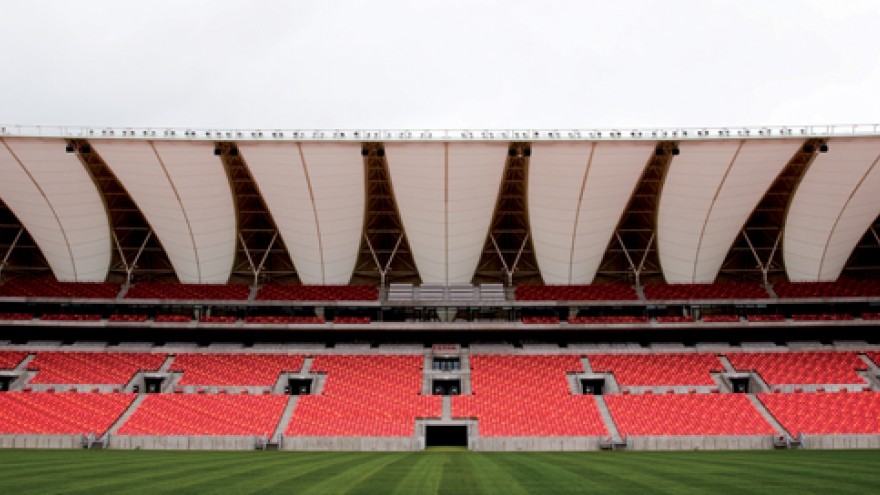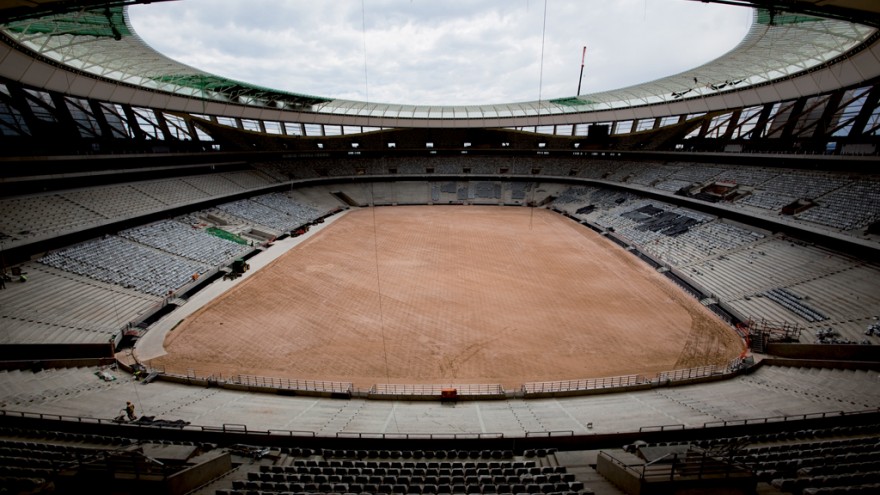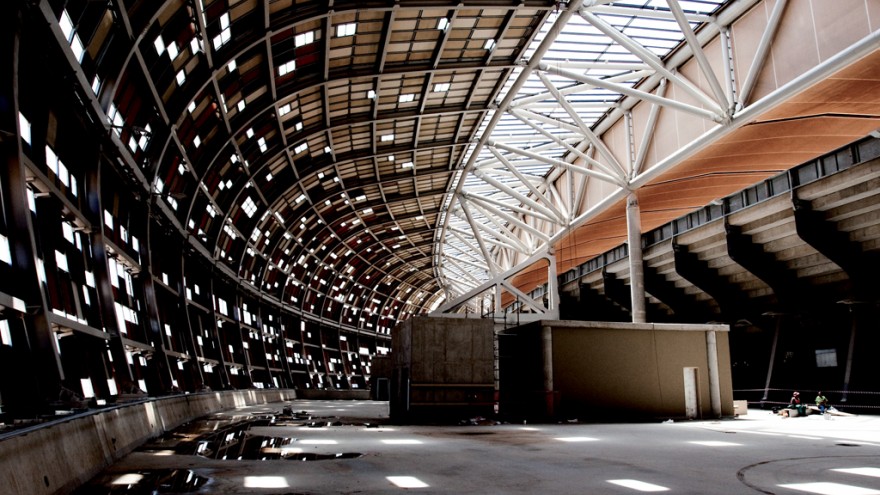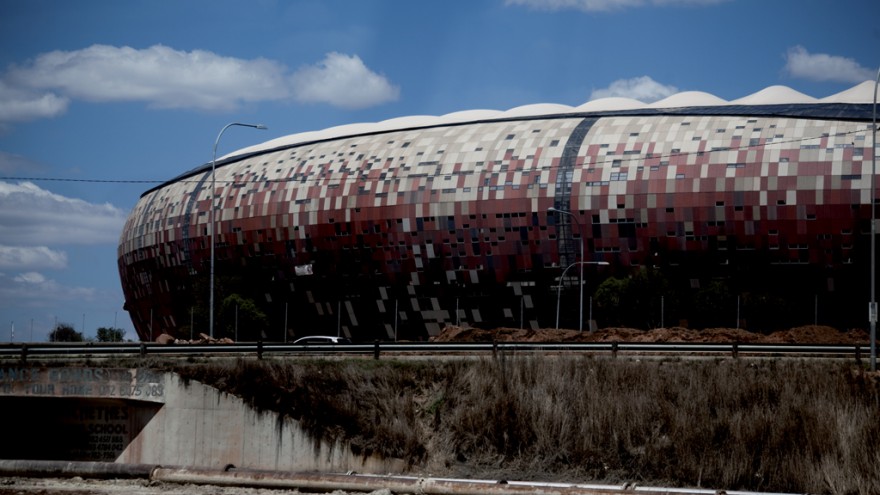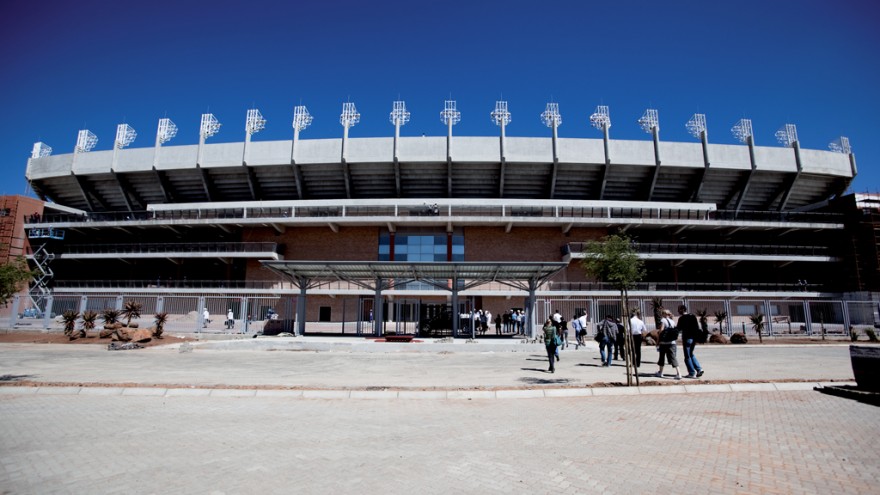First Published in
Nelspruit: 1.05. Cape Town: 4.40. Soccer City: 3.30. Port Elizabeth: 2.05. Durban: 3.40. This is not a beauty contest rating, but the cost, in billions of Rand, of South Africa’s new FIFA World Cup stadiums. And what do we get for that money?
Some of our stadiums needed nothing more than a bit of make-up, some glitter and light cosmetic surgery. That was the case of Ellis Park (Johannesburg), Loftus Versfeld (Pretoria), the Royal Bafokeng (Rustenburg) and the Free State (Bloemfontein) stadiums. These were upgraded to look at their best and to meet the strict FIFA requirements. This means, for example, a minimum of 43 000 seats all with good views of the pitch and a certain amount of shade, facilities to entertain at least 3 000 VIPs, room and broadcasting networks for the international media, intense floodlighting, a state-of-the-art sound system, and some of those flashy electronic score boards.
The flagship Soccer City (Johannesburg), the stage for the first and final games, underwent not only a minor facelift, but received a completely new shell and can now accommodate an impressive 97 000 spectators, none of them seated more than 100m from the action. The makeover has branded a new image on the old FNB stadium, which is engraved in South African history as the place where Mandela led the first mass rally after his liberation.
On the outside, it looks like a calabash, chosen as a Pan African symbol of community and sharing. Under the calabash, comes the “pit of fire”: When the stadium is full at night, the illuminated ground level glows. It is not at all easy to represent the clay skin of a cooking pot when it is magnified thousands of times. There were various design changes for the facade panels, until the designers settled on aluminium, but tenders came back too expensive. By chance, the team came across an Austrian product called fiberC, made of concrete laminated with fibreglass, with a very low embodied energy. 40 000 panels, made in six colours and three different textures, were assembled on site as a giant mosaic in tones of red.
Like calabashes have patterns, the facade has 10 vertical slots. Each points towards the geographical location of the nine other South African stadiums. But as nine is bad luck in African numerology, a 10th one was added to indicate Berlin, where the last cup was held. For each game played in the nine stadiums, the score will be inscribed in a concrete panel set in the matching line.
By nature, stadiums are always over-sized, out-of-scale buildings. Often they become sculptural objects, running the risk of outsizing their surroundings and landing like alien ships on the suburbs (ring any bells?). Green Point Stadium (Cape Town) is one of these solitary bodies – scaleless and imposing a new silhouette against the backdrop of Signal Hill and Table Mountain. It has changed Cape Town’s skyline in a dramatic and ubiquitous way not seen since the Tampon Towers were erected. The choice of site – right in the city – and the visual impact of the project were much debated. The design architect reportedly had sleepless nights wondering whether the building was right for its location. And so it seems, it was.
As nothing should compete with Table Mountain, the sweeping shape avoids horizontal lines. Wrapped-up in ETFE fabric, a stretched fibreglass material, it plays with transparency as if with veils. The diaphanous skin glows when lit, revealing the skeleton of the steel structure inside. During the day, it absorbs the ambient light, changes hue with the weather and the time of the day, and reflects the mood of the city, which made the designers nickname it “the Diva of Cape Town”.
Seeing as winter in the Western Cape can be pretty moody, the roof plays an essential role. It is built as a giant bicycle wheel, entirely covered in glass. In an engineering magic trick, the “spokes” were laid on the ground and slowly raised by tensioning 72 cables, leaving the roof mysteriously suspended. Glass sounds like a fancy choice, but it has its reasons. First, the weight of the glazing holds the wheel down in the strong winds. It also acts as a sound buffer. A translucent fabric ceiling doubles the roof and the sound gets trapped between the soft fabric and the hard glazing. And finally, it gives a sleek upper facade to the building, which will be seen from surrounding hills.
Around the stadium, Green Point is already undergoing a very fast gentrification. Cafés, hotels and fast-food chains are sprouting. The Green Point Common is being restructured as an urban park linking town and beach, irrigated by rainwater collected on the stadium’s glass roof. The stadium will be the centre of new pedestrian and cycling ways, and a stop on the new Bus Rapid Transit route. This could change Capetonians’ transport habits. With talks of greening the city and revising transport strategies, the stadium is a trigger for urban renewal on a wider scale.
Durban is also getting much more than a sport facility. Moses Mabhida Stadium is the new icon of the city – from now on a view from its grand arch is the best selling-point for local property. The arch is the beacon of this intention to be the sports capital of South Africa. Towards the south, the two legs of the arch frame the view onto the city and the new Peoples Park. Not shy of making a statement, the design is inspired by the Y on our national flag: The double arch, rising from either side of the main entrance, merges into a single one, symbolising the re-united nation. A simple idea transforms the arch itself into a tourist destination: The apex, 106m above the pitch, is accessible by foot, which looks quite adventurous, or by a cable car, leading to a platform with views over Durban and the Indian Ocean.
The stadium was designed as the centrepiece of an ambitious and generous scheme: A huge precinct of green areas for leisure, social use and up to 40 types of sports. Peoples Park is the garden part, with cycling and running tracks, water features, and a restaurant to chill at. On the northern side of the stadium, Imbizo place is the mingling part, whether there is an event on or not, with shops, bars and cafés. The complex is directly linked by walkways, trains, and rides to town and the beach 200m away. Every day of the year, there will be activity.
The stadium’s facade itself is an open screen of white vertical lamellae, which makes use of passive solar energy in winter, reflects most of the radiant summer heat and lets the breeze in. It is like a venetian blind turned on its side and as one walks around the stadium, the angled slats reveal constantly changing views of the inside facade and the surroundings. Spectators access the arena high above the field, at the top of the lower tier, so the first glimpse at the arena is a spectacular bird’s-eye-view. It also allows savings on stairs, making the circulation simpler and quicker. The multicoloured seats take their hues from the people, ocean, beaches and skies of the region. The light roof is a pleated translucent membrane of fibreglass fabric coated with PTFE (a type of Teflon).
In contrast, the architects’ approach to the Mbombela Stadium (Nelspruit) was truly pragmatic: To give the province of Mpumalanga a world-class venue without indebting the city. The budget allocated by the National Treasury was carefully adhered to and the construction is sound and simple. Most of it was even made in South Africa – unlike its siblings, Mbombela Stadium has a roof made-in-Jozi.
Although the 18 pillars supporting the roof started as simple structural elements, they lent themselves to becoming something else and took the shape of symbolic, Lego-style giraffes. On the outskirts of Nelspruit, the stadium is just a stone’s throw away from the Kruger Park. It is the first large-size venue in the heart of the Lowveld. Continuing on the wildlife theme, the seats are used like pixels to compose a funky oversized zebra pattern running around the bowl. If whimsical, these unusual features give the stadium an unmistakable identity. The interiors pay tribute to local decorating traditions, using the geometric and colourful Ndebele patterns.
The design of the Peter Mokaba Stadium (Polokwane) also plays with the postcard picture of southern Africa. Fair enough: The site itself is the archetypal savannah. There the assembly will gather under four giant baobabs and, from the upper concourse area, lucky spectators will be able to spot giraffes, elephants and zebras. The thick trunks placed at the corners contain the lifts and access ramps and the branches are the sole support to a roof that spans 176m – that’s first-class engineering. Polokwane is buzzing with excitement. The World Cup has put the town on the international map. The roads and the airport are getting extended and upgraded, and new guesthouses open their doors daily.
Stadiums around the world are commonly introverted, but South Africa’s new 2010 stadiums are unusually open to their surroundings, decisively celebrating our mighty landscapes. Durban and Cape Town have the sea as their stage, and the Nelson Mandela Bay Stadium (Port Elizabeth) is set on the shore of the North End Lake with spectacular views across it.
The monolithic roof envelope hovers above the ground, like a sunflower, some say. Others call it a crown. It is made of hollow shells regularly ordered as a colonnade. The metallic girders were shipped all the way from Kuwait, assembled and clad in aluminium. They are linked together by, again, the Teflon-type PTFE membrane. Its popularity for big structures around the world comes from its ability to transform fabric into weatherproof facades. It sticks well to fibreglass but, like in your frying pan, nothing sticks to it – not rain, not dirt. Nelson Mandela Bay Stadium has already been introduced to international TV as the stage of the Miss World sports-leg of the 2009 pageant.
And what of after the World Cup? As mentioned, most of the stadiums are oversized for their location and the public generally fears to be left, after astronomical expenses, with 10 sparklingly empty stadiums. In many cases though, the excess seats are temporary, set to disappear or be transformed for long-term use after 2010. Also, they are more than just a football pitch. The multi-use stadiums can be used for rugby games, concerts, rallies, expos... and anything else that operators can imagine to make them a commercial success. That is a promise for some exciting entertainment. On Durban’s side, the city is eyeing the 2020 Olympics and the new stadium has made the city eligible for the bid.
On the social aspect, the success of the stadiums’ construction is highly debatable. Building sites were ridden by workers’ strikes over ridiculously low wages. In a confusion of improvement and hypocrisy, people living in the shadows of the stadium have seen their homes demolished, as an eyesore to photogenic surroundings. Schools have been kicked out too.
Nevertheless, in the construction sector alone, 50 000 jobs are said to have been created by the World Cup. Workers have been trained to high standards, generally raising the level of skills in the industry. The event itself will contribute R21 billion to the GDP and generate R17 billion in government taxes. In the long term, this is good for everybody.
Further, with 2010 as an unmovable deadline, municipalities have grabbed the opportunity to develop neighbourhoods, re-thinking infrastructure and the sensitive topic of transport strategies. Cities have been made more friendly and beautiful, and launched social and eco-conscious projects. Elsewhere in the world, such initiatives, once started, have generated more and more, and have in the end made a great difference to the quality of life.
At stake is the image of a whole continent. Africa is still essentially perceived as dry lands doomed by war and hunger. South Africa, as its ambassador, will show the continent as hard-working, talented and fun. What we will be left with: Some of the most beautiful stadiums in the world. As they came off the ground, they became the concrete manifestation of the big party coming up in a few months’ time. Entering them filled me with the warmth, excitement and pride that is slowly filling the air in anticipation. The collective ego boost and self-confidence will linger for much more than six weeks. So, if you ask me, yes, it is worth it.

